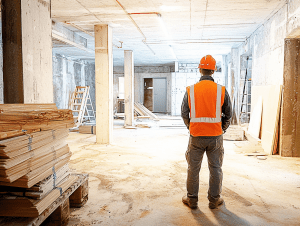Common Passive Fire Protection Failures Found During Inspections
 Identifying and addressing failures in passive fire protection is essential for safeguarding people and property. At LPP, we routinely uncover critical issues during fire safety inspections that compromise compartmentation and slow evacuation. Understanding these risks is key to prevention and long-term safety.
Identifying and addressing failures in passive fire protection is essential for safeguarding people and property. At LPP, we routinely uncover critical issues during fire safety inspections that compromise compartmentation and slow evacuation. Understanding these risks is key to prevention and long-term safety.
1. Incomplete or Poor Fire Stopping
Inadequate sealing of service penetrations is one of the most frequent failures we observe. Gaps around pipes, cables, or ducts that have not been properly treated with approved fire stopping materials can allow smoke and flames to spread between compartments. Our Fire Stopping Installations service ensures these areas are fully protected.
2. Missing or Damaged Intumescent Materials
We often find intumescent wraps, sealants, or collars that are missing, damaged, or improperly installed. These materials are essential to expand and seal voids during a fire. All components must be part of a certified system and maintained accordingly, as part of comprehensive Passive Fire Protection Services.
3. Breached or Incomplete Fire Compartments
Fire-rated walls, ceilings, and floors must form continuous barriers. However, we regularly see breaches left unsealed during renovations or service upgrades. Such gaps negate the entire purpose of compartmentation. Our Fire Compartmentation Safety Surveys help locate and document these weaknesses for remedial action.
4. Incorrect Use of Materials
Using non-approved fillers, foams, or mastic that aren’t fire-rated is a common mistake. Only tested and compliant systems should be used for passive fire measures. LPP’s experienced team ensures all installations meet strict product and system approvals, including Accredited by BM Trada certification standards.
5. Overlooked Structural Protection
Structural steel is often left unprotected, or intumescent coatings are incorrectly applied. This can cause premature collapse of the building in a fire. Our Steel Fire Protection services ensure beams and columns maintain their load-bearing ability during critical fire conditions.
Ongoing Inspections and Maintenance
Even the best fire protection system can fail without proper maintenance. Our role as a trusted name among Passive Fire Protection Companies includes scheduled inspections and repairs to prevent fire safety compliance issues before they arise.
How LPP Can Support Safer Buildings
LPP offers a full range of Passive Fire Safety solutions—from installation to inspections and remedial works. Whether you manage commercial facilities or residential blocks, we provide critical fireproofing support tailored to your building’s needs. Our services contribute to Buildings and Fire Safety across the UK.
Conclusion
Passive fire protection is only effective when it is complete, maintained, and properly installed. Common failures found during inspections highlight the importance of expert support and certified practices. Contact LPP for reliable, standards-compliant protection across all fire safety elements.
